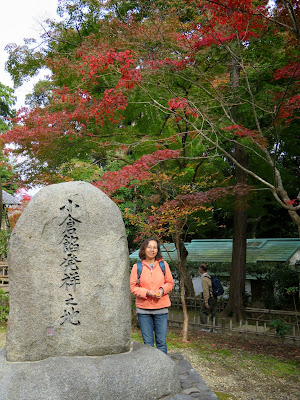
Nison-ji which means a temple with two principal images, was originally called as Ogurayama Nison-in Kedai-ji. It was founded in early Heian, initiated by Emperor Saga in year 834 and built by Priest Jikaku Daishu also known as Ennin (793-864) between years 834 to 847. It situates at Mount Ogura, a site totally hidden away from the bustling touristy spot in Arishiyama. Nison-ji belongs to Tendai Sect of Japanese Buddhism and currently is part of Enryaku-ji Temple group of Japan.


Sommon Gate which was removed from Fushimi Caste, was built in year 1613. The name on top of the gate was bestowed by the 104th Emperor Gokashi Wabaga (1464-1526)


The 200 meter straight walking path after the Sommon gate is called as Momiji No Baba which literally means autumn leaf horse-riding ground. It is an avenue of Momiji Trees and a famous spot for fall foliage.








Autumn leaves just began to turn red


It was simply beautiful




















The garden at temple grounds is quite small but attractive.



The Chinese styled Karamon Gate standing at the end of Momiji walk path leads to the Hondo main temple.


The three characters of the temple name at Hondo Main Shrine hall, was bestowed by The 105th Emperor Gonara (1495-1557). The three lines of advices read as: Do good deeds, avoid evil deeds, benefit others rather than yourself are part of our Buddhist teachings.



Before the restoration in Meiji era (1868-1912), Nison-in was designated as one of the four auspicious temples in the past. It practiced the observance of ceremonies at the nomination of a chief monk. It was a custom at that time, for a priest to visit the imperial palace when he was nominated as an abbot, to receive the purple robe, the symbol of the highest rank in Buddhism.



None of the original buildings built in 9th century were survived in Onin War (1467-1477). The Hondo Main shrine hall and Karamon gate were restored 30 years later after burnt down by the fire. Most of the present buildings were rebuilt in year 1613.


Hondo Main Hall enshrines two Buddha Images as its Principal worship, one is the founding Gautama Buddha of Hakken who guide humans in the present life and send them off to the next life while Amitabha of Raigei, he greets and welcomes those who had passed away from this life. Both images are listed as national important cultural properties of Japan. We were blessed to have a chance to personally kneel and bow to them and were further allowed to take a picture of it..



The temple was nestled in a wooded forest of rich greenery.



The bell tower and statue of founder Master Jikaku Daishu placed behind the Hondo main hall.



Near the bell tower are flights of steep stone steps approaching to the hilltop, where the renowned ancient imperial cemetery for emperors and members of aristocracy are located.



The location of temple on Mount Ogura was said to have been the site of villa belonging to a famous Waka Poet Fujiwara No Teika (1162-1241), who compiled the anthology of 100 Waka poems by 100 poets. Mount Ogura offers a panoramic sight of the town below.


The burning foliage at hilltop







This is the origin place where the temple once stood.



The moss garden



No comments:
Post a Comment